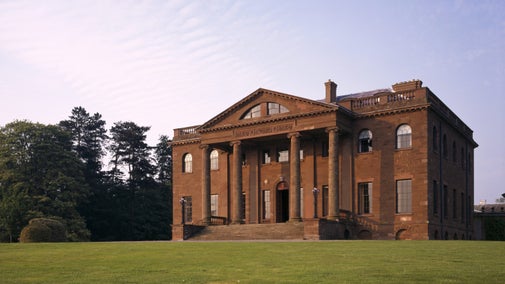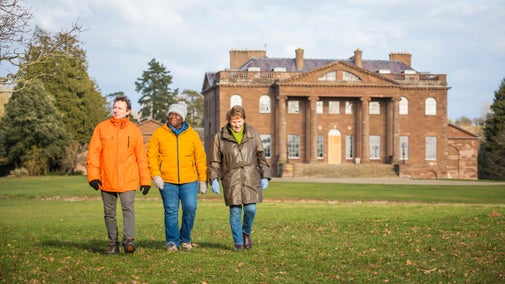
Berrington Hall's collections
Explore the objects and works of art we care for at Berrington Hall and on the National Trust Collections website.

Berrington Hall was created as a country retreat more than 230 years ago for city banker and businessman, Thomas Harley, who wanted to escape to the country. His grand design was to be the final work by famous landscape gardener, Lancelot ‘Capability’ Brown. Since then, only two other families have owned the property: the Rodneys and the Cawleys.
Thomas Harley bought the estate in 1775 after making his fortune as a banker and government contractor in London.
He had long family links with Herefordshire and by his mid-forties, he felt the urge to return to his county of birth as a relief from the hurly-burly of city life.
Harley commissioned ‘Capability’ Brown to lay out the park, which has spectacular views west towards Wales and the Black Mountains.
In 1778 he also called in Brown’s son-in-law, Henry Holland, to design him a new house in the latest French-influenced Neo-classical style, using the finest London craftsman.
The most fashionable and iconic landscape designer of the Georgian era; 'Capability' Brown was commissioned to create what was to be his final landscape design at Berrington.
Brown had worked his magic at around 254 sites prior to Berrington and the skill in his craft can be seen in the mature park today. It’s likely that the landscaping work started before Harley's new house was constructed, with Brown advising the location.
He created his typical open sweep of grassy parkland from where the house was to be positioned, over a ha-ha and down to an eye-catching feature, the construction of a 14-acre lake.

Harley had no male heir, but was delighted when in 1781 his daughter Anne married the son of Admiral Lord Rodney, a great naval commander.
On Harley’s death in 1804, Berrington passed to the Rodney family, who lived there for the next 95 years through seven generations.
Lord George Rodney inherited the estate at the age of 7 in 1864. He spent little time at the house in his early years, leaving Eton to join the army and seeing active service in Egypt and the Sudan.
In 1891 he married the Honourable Corisande Evelyn Vere Guest, at St. James’s Church, Piccadilly. His bride came from a noble family and it was considered a good match.
Shortly after the honeymoon, a tower in rendered brick was built in the courtyard to provide bathrooms and lavatories. Corisande refused to move to Berrington until a bathroom tower had been built, having been used to plumbed-in baths where she'd lived previously.
There were a couple of fires at Berrington during the time the couple lived there, one costing around £700 in renovations (around £50,000 today).
Lord and Lady Rodney had four sons, George (1891), James (1893), Charles (1895) and William (1896) and initially enjoyed the social scene of the surrounding area. However, the 4,000-acre estate never recovered from the agricultural depression of the 1870s and the 7th Baron built up significant personal debts.
To raise cash, he sold the Gainsborough portraits which hung in the dining room and valuable books collected by Harley’s ancestors. More and more items were sold, until finally in 1901 he was forced to sell the house and estate.
The marriage turned sour and, in 1902, Corisande filed for divorce, citing cruelty and adultery as her reasons for petition.
Lord Rodney married again in 1903 to Charlotte Eugenia Probyn, whose family were Gloucestershire gentry, and died in 1909, in Denmark Hill, London, aged 52.

In 1901 Queen Victoria died. The country went into mourning which was good news for the new owner of Berrington, Frederick Cawley MP (later to become Lord Cawley). He owned the patent for a pure black dye which made his cotton finishing business the most successful in Lancashire.
Cawley was a self-made man who had also become a Liberal MP. He originally purchased Berrington as a convenient stop off between his Manchester base and politics in London. He became a Baronet in 1906 for services to the Liberal Party.
Around 1908, he began a comprehensive but sensitive redecoration of the mansion and many of his schemes still survive today. He replaced Victorian fire grates with more appropriate Georgian models, but otherwise did little to disturb Holland’s beautiful original design.
He added the Wedgwood plaques in the Drawing room and installed the Aubusson tapestries in the Marble and Staircase Halls, to replace the gaps left by the pictures sold by the Rodneys.
The family suffered hugely in the Great War, losing three of their four sons.
The second Lord Cawley married Vivienne Lee, also from a cotton trading family, and took over the mansion upon his father’s death in 1937.
The Cawleys suffered again during the Second World War, losing a son at Tunis in 1943.
Berrington Hall survived unscathed and was used as a convalescent hospital run from the temporary office in the Boudoir, by Lady Cawley.
After the war, she used the small room at the back of the house as her sitting room. Today the room is arranged to commemorate the family and reflect their lives.
When the 2nd Lord Cawley died in 1954, the estate was handed over to the Treasury as part payment for the death duties. In turn, it was given to the care of the National Trust.
Lady Cawley continued to live at the house until her death in 1978, at the age of 100.

Explore the objects and works of art we care for at Berrington Hall and on the National Trust Collections website.
Georgian grandeur on a human scale; neoclassical mansion by Henry Holland set in 'Capability' Brown's final landscape and gardens

Lancelot 'Capability' Brown was one of the UK's most celebrated landscape gardeners. Find out how this Georgian gentleman created the quintessential English landscapes that we see at many of the places in our care today.

Berrington has an internationally significant garden. It’s the final landscape garden project completed by Lancelot ‘Capability’ Brown with a walled garden, traditional orchard, productive kitchen garden, curved garden and a brand new flower garden.

Berrington Hall is a bold red sandstone mansion contrasting with delicate neo-classical interiors and a rare masterpiece by architect Henry Holland.

Explore Lancelot 'Capability' Brown's vision of stunning views and winding walking trails through acres of parkland at Berrington.

Brown designed landscapes that fitted in seamlessly with the surrounding countryside. So how do you spot the designs of one of the greatest gardeners of all time?

Learn about people from the past, discover remarkable works of art and brush up on your knowledge of architecture and gardens.

From landscape gardeners to LGBTQ+ campaigners and suffragettes to famous writers, many people have had their impact on the places we care for. Discover their stories and the lasting legacies they’ve left behind.
